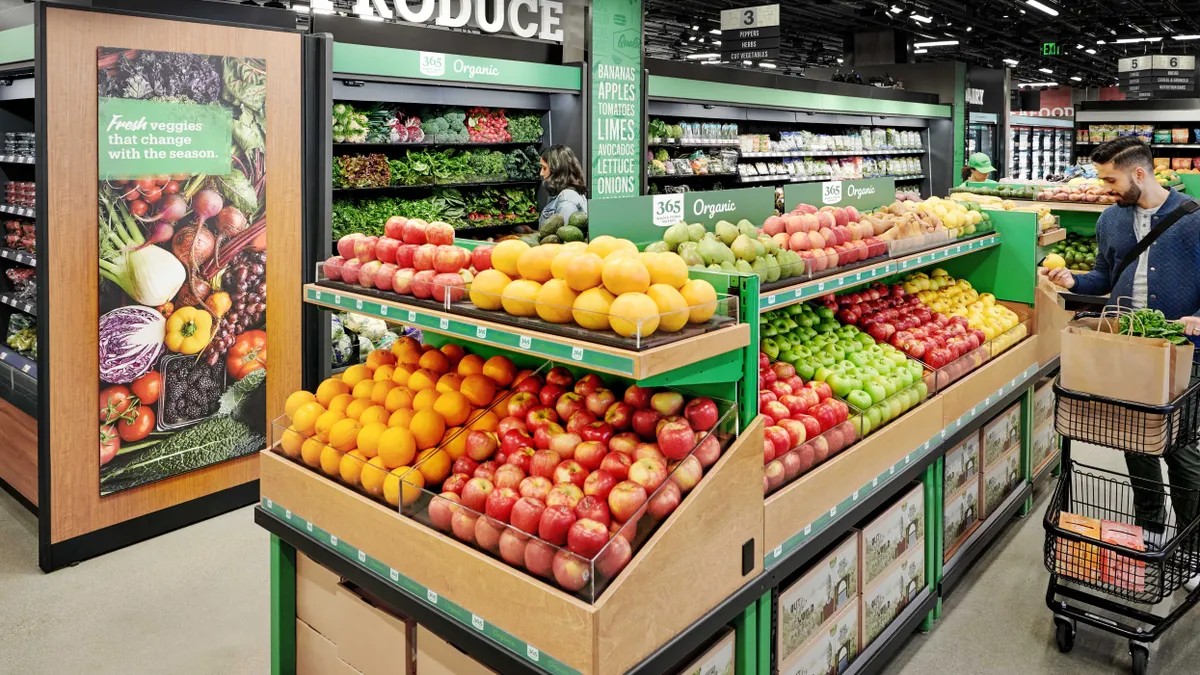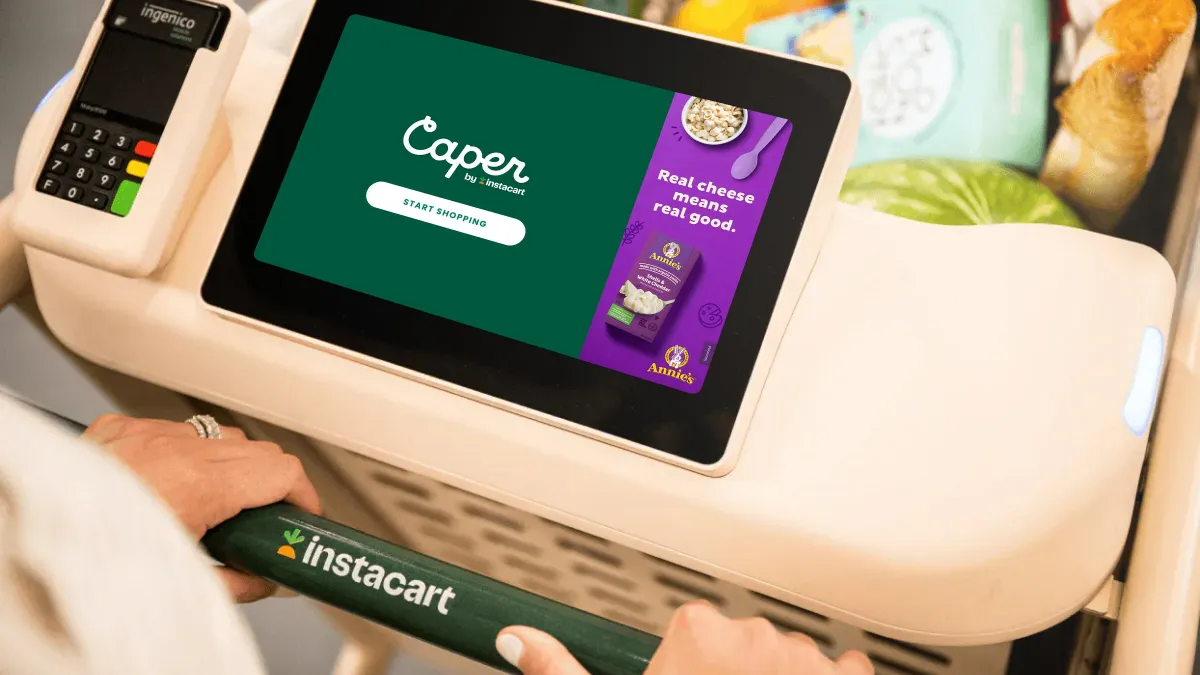Over the past few months, it’s become clear that Amazon is not just amassing a collection of grocery stores. It’s building a grocery ecosystem.
With the addition of Amazon Go Grocery earlier this week, the company now has five grocery or grocery-adjacent brick-and-mortar brands in its arsenal. And each of them covers unique markets and consumer needs. Whole Foods is its specialty brand, while the yet-to-open supermarket in Southern California appears to be its more conventional offering. Amazon Go and Go Grocery cover urban markets, while Amazon Fresh Pickup, which has yet to expand beyond two Seattle locations that opened in 2017, is a click-and-collect depot similar to ones Walmart and Ahold Delhaize have built.
Amazon is also attacking e-commerce with a diverse collection of pure-play and store-based strategies. It’s investing heavily in Amazon Fresh at what looks to be the right time. It’s also expanding delivery and pickup from Whole Foods, and reports show it’s pursuing speedy delivery and pickup from its Woodland Hills, California supermarket.
That still unnamed store will include a micro-fulfillment center built by Dematic, according to a report from media entrepreneur Matt Newberg — a development that raised eyebrows across the industry. (Both Dematic and Amazon have declined comment on the matter.) That’s because, while other grocers are also testing micro-fulfillment centers, the technology is particularly dangerous in Amazon’s hands given its near-limitless capital and technological expertise.
Taken together, all of these developments prove Amazon is committed to a long and aggressive grocery offensive. They furthermore paint a picture of a grocery competitor that’s trying to significantly raise the bar on convenience.
“Amazon cannot just go head-to-head with Walmart and Kroger in opening the same number of stores," Brittain Ladd, a former Amazon executive who now consults on e-commerce and supply chain operations, told Grocery Dive Wednesday. "Amazon has to open better stores.”
Experts have pointed out that Amazon isn’t a very strong physical retailer and that its history in online grocery hasn’t been very stellar so far, with a confusing array of offerings that includes Prime Pantry, Fresh and its gigantic online marketplace.
That’s true, but Amazon remains incredibly dangerous for numerous reasons. First, there’s the company’s enormous resources. Grocers are used to competing against retailers that are constrained by slim margins and the need to make money on most, if not every, initiative they undertake. Amazon doesn’t have those same constraints. Its diversified business and $800 billion market capitalization allows it to rapidly build out its operations and absorb missteps. Failing often is part of the company’s business plan.
Amazon’s long-term ecosystem strategy also looks very savvy. It’s the same game plan some of the smartest grocers in the business, like Hy-Vee and Publix, are deploying. But rather than start out in conventional retail and then diversify into smaller formats, a multi-front approach is foundational for Amazon in grocery. That the company was able to map out this strategy testifies to its ability to read consumer demand and the industry’s trajectory.
It’s also learning and adjusting. Amazon Fresh was a failure as of two years ago, when the company pulled out of numerous markets. It’s now on the comeback trail, having integrated with Prime and done away with the cumbersome $15 month fee, and reports show consumers are rapidly adopting the service. Amazon Go, meanwhile, has become more service-oriented over time than many people realize. Stores have added personnel at the entrance to answer questions, help shoppers download the app and then swipe in.
James Richardson, a Seattle-based author and consultant with Premium Growth Solutions, said workers are stationed throughout the Go Grocery store in Seattle. “The idea that the store is missing human interaction is misplaced,” he told me via email. He sees the format as a smart strategy for appealing to a specific consumer set and feeding its Prime flywheel.
“Amazon is perfectly set up to go in, lose a little money per store, and service elite, high spending Amazon Prime members with a clever mix of iconic but mostly premium brands,” Richardson said.
According to Ladd, Amazon’s learn-and-adjust strategy will extend across its budding grocery empire. Right now the company is unveiling its various weapons, he said. It will gradually expand each and see what works and what doesn’t. It will accelerate formats that perform well and cross-pollinate technology and strategies as necessary. Although Amazon has stated it doesn’t plan to bring checkout-free technology to its new supermarket chain or to Whole Foods stores, that doesn’t mean it won’t eventually take this step if the system hits home with shoppers and becomes truly scalable and cost-effective.
Ladd along with other sources I spoke with also believe Amazon will eventually incorporate micro-fulfillment into the center of its supermarket selling floors, allowing robots to gather center-store groceries while consumers shop perimeter departments. It's a model similar to one imagined by e-commerce consultant Locai in partnership with architectural firm Cuhaci & Peterson.
“Amazon has to have a competitive advantage, and the way it will compete is in better use of technology, better use of robotics so that they operate a store that operates with a lower cost, and that allows Amazon to be much better on price and still make a profit,” Ladd said.
It should come as no surprise that Amazon is taking an ecosystem approach to grocery. It's reflective of the company's vast and interwoven empire, which includes web services, consumer hardware, streaming video and other offerings that all feed data and consumer dollars to one another. Amazon marries these vast resources with a corporate mindset that encourages bold ideas, Ladd said.
Ultimately, Amazon is unlike any company grocers have ever dealt with — a persistent, nearly invulnerable competitor that has the luxury of transcending traditional measures of failure and success. While that doesn't guarantee the e-tailer will take over the industry, it means it certainly has the capacity to do so.
"Amazon does not think of itself as a grocery retailer," Ladd said. "They believe they are re-imagining the grocery experience."




















